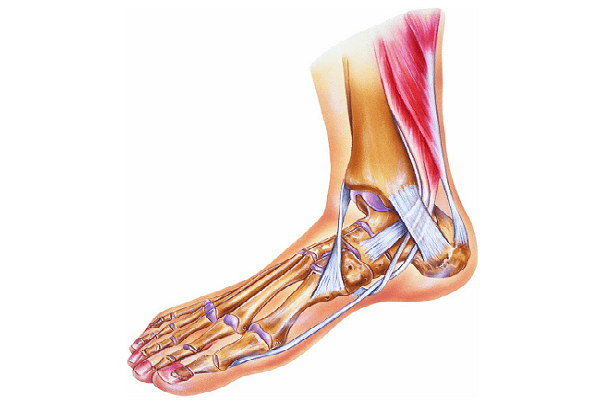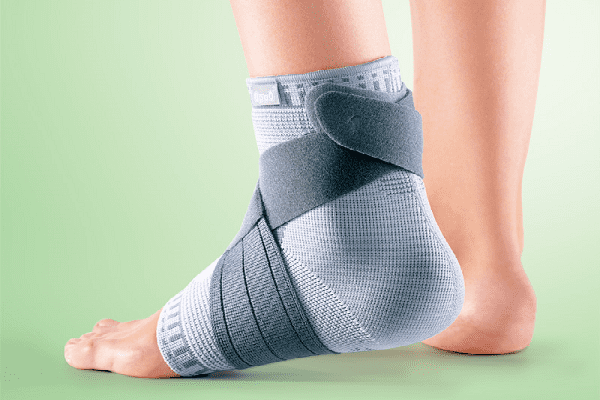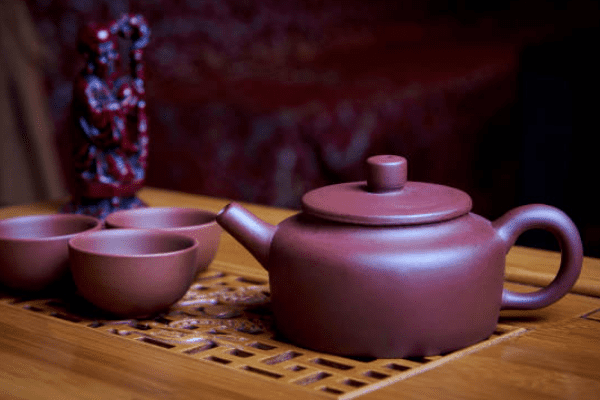Therapeutic exercises >>>> Exercises for ankle injury
Exercises for ankle injury.

The ankle joint is one of the most mobile, and the most difficult to recover, since usually ankle injuries touch the inner parts of the joint: ankle ligament ruptures, capsule ruptures, intra-articular fractures (ankle).
The ankle joint allows the foot to rise and fall when walking, turn to the sides by a significant amplitude, and turn the foot with its edge toward the surface. This allows the person to balance and maintain balance while moving on uneven surfaces. The joint has a complex ligamentous winding and, in fact, is a stable connection, and yet injuries are inevitable in case of unsuccessful turning of the foot, when falling on the foot with all the weight of the body.
Restoring the mobility of the ankle joint is a guarantee of the future ability to move around without devices and outside help. The beginning of rehabilitation exercises falls on the period when the leg is in a cast. Immobilization of the joint does not make it possible to perform any movements directly in the area of the joint, but the toes have the ability to move, which is extremely important to use during the period of wearing a plaster cast.
Finger immobility leads to muscle atrophy and can cause seizures, which are extremely difficult to overcome in a plaster cast. Therefore, the first rehabilitation exercise for an ankle joint injury is the movements of the toes: move the fingers in a wave-like manner (alternately bending and unbending the fingers one after the other), alternately bending all the fingers together and straightening them - repeat 20 times three times a day.
Exercise 1. is done in a lying or sitting position, so that the leg is freely located along a flat surface.
Exercise 2. The leg is located along a flat surface (not suspended): strain and relax the calf muscles without moving the leg. Do the exercise 20 times, three times a day.
When the plaster cast is removed, it is recommended to wear an orthosis that will restrain the range of motion in the ankle, temporarily limiting circular and lateral movements. At this time, the foot can move up and down, which will form the basis of the next set of exercises.
Exercise 3. In a sitting or lying position, put your foot on an even support, straighten it and put it on the heel, so that the foot is at a right angle, put a soft roller made of a twisted blanket or towel in the ankle area. This will create additional support and relieve the muscles of the articular apparatus of the ankle during exercise, so that the leg is not "on weight". With such insurance in the foot, perform the following movements: tilt the foot towards yourself (toes towards yourself) with the formation of an acute angle (do not bend the toes), trying to stretch the ligaments and muscles as much as possible (but without painful effect). Hold in this slope (30 sec), then move to the starting position. Next stretch the foot (as in ballet), without bending your toes, fix it for 30 seconds. and return to its original position. Repeat the exercise 20 times in three passes a day.
Exercise 4. In a sitting or lying position, the legs are located along a flat surface, the feet are parallel and shifted close to each other, the heels are closed, the toes are closed. Open the socks one by one (without opening the heels) and spread them to the sides with maximum opportunity. Return to original position. Then open the heels and spread them apart, without opening the socks. At the same time, the feet should be at a right angle to the ankle at all times. The exercise is repeated in turn 20 times in three runs a day. The number of movements is increased daily by 5-10 for each call.
Exercise 5. Imitation of pedal foot movements. In a sitting or lying position, raise your legs slightly above the surface and move your feet alternately, as if you are pressing the pedals of a bicycle. Attention! The knees are not involved in the movement. Do the exercise for 1 minute in 10 sessions a day.
The next set of exercises is carried out with a finally healed injury and restored joint flexibility. These exercises will restore the stress on the joint that it would normally withstand when walking.
Exercise 6. In a standing position, lean on a wall or the back of a chair and rise on your toes. Lower to the starting position. Repeat the exercise 20 times in three sets a day. Daily increase the number of lifts by 5-10 times in each run. Always do the exercise with support.
Exercise 7. Roll up a tight roll of towels 4-6 inches high and put on the floor. With support against the wall or the back of a chair, alternately climb up and down the roller. Exercise to do one minute (keep score for synchronization of movement: one - two (both feet on the roller), three - four (both feet on the floor).
Exercise 8. Circular motion of the feet. In a sitting position on a chair, raise your legs 4 inches from the floor and, while suspended, make circular movements with your feet for 30 seconds. Repeat the exercise 10 times a day.
Exercise 9. Walking on an incline, walking with a turn of the foot with an edge (inner and outer side), walking on toes and walking on heels. It is advisable to perform these types of exercises with support when walking, so as not to lose balance and not cause new injury to the fragile joint.

In the future, it is recommended to protect the ankle joint, and all exercises (walking, running, exercise bike) should be performed with the joint fixed (bandage with an elastic bandage).
In many ankle injuries, ligaments can rupture in parallel with a fracture, muscle strain or capsule rupture. But it is worth knowing that the ligaments in the ankle are sutured only in case of significant damage, and in all other cases, the connective tissue of the ligaments is able to regenerate, filling the gaps - by building up cells, so that any movements in the ankle after injury will contribute to accelerated regeneration of the ligamentous apparatus. which is the insurance for the joint during its movement.

Read

Read


























